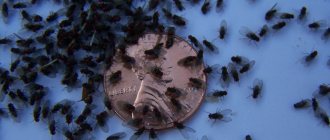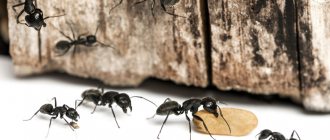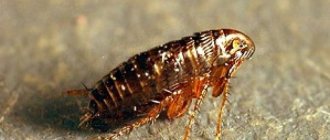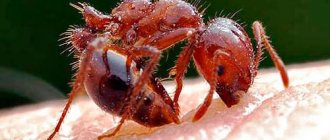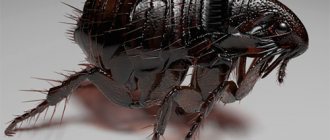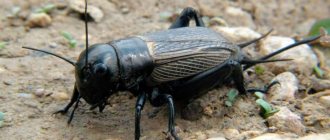- Posted by Natalia Slovina
- Date: March 30, 2017
In fairy tales, crickets are always positive heroes; many good omens are associated with them. That is why in life a person’s attitude towards these insects is good-natured and condescending.
- 2 Why and where do these insects appear in an apartment or house?
- 3 How to get rid of crickets (with reviews)
3.1 Traps
- 3.2 Traditional recipes
- 3.3 Chemicals
3.3.1 Comparative characteristics of methods to combat crickets
Description and features of the insect
The cricket, which lived in the desert climate of Asia and Africa, quickly spread across all continents.
Appearance
The length of the body of a bug with developed and strong wings does not exceed 2.5 cm. Insects have different colors, some individuals are very light, others have a dark brown tint. Of the three pairs of legs, the hind limbs are designed for jumping. The female cricket lays several hundred eggs, from which wingless larvae emerge. The insect lives up to 4 months and then dies.
How to recognize by sound
Warmth and food attract bugs to human homes. The monotonous trills emitted by crickets at night when they are awake are very annoying, but catching a moving insect is not easy.
How and why they sing
With sounds that prevent people from getting enough sleep, males lure females during the mating season and mark the boundaries of the territory so that the enemy does not lay claim to it. There are folds on the insect's wings that vibrate when they touch, producing a chirping sound.
A cricket appears in the house - what to expect?
Crickets have been living near people since ancient times. It is not surprising that many superstitions were born about this restless “tenant”. A folk sign states that the appearance of a “singer” in a house portends joy, good luck, wealth and prosperity for the owners. In addition, there is a belief that if there is a sick person in the house, he will soon recover, and if there is a bride or groom, then one should prepare for the wedding. But killing a cricket is not recommended as it may bring bad luck to the house.
How to treat these signs is up to everyone to decide for themselves. In reality, it should be remembered that these insects strive to get into human habitation in search of warmth and food. And the purpose of the “songs” - the trills of the male - is to lure the female. In any case, after a couple of sleepless nights you have to decide how to remove the crickets.
Reasons for appearance
In the south, crickets are comfortable in natural conditions; in the northern regions and temperate latitudes, by the fall the bugs move to heating mains, basements, and spend the winter in houses and apartments.
Light
Although crickets sleep during the day, having found a secluded place, they become active at night, hunt for food, fight with enemies who have come to their territory, and bright light attracts singing insects to people’s homes.
See also
Instructions on how to make a rock garden with your own hands
Smell of garbage
Leftover food in a warm room quickly begins to rot; crickets, sensing a specific aroma, head to the place where the smell comes from, since they are not averse to eating spoiled food.
High humidity
Even insects that have lived for a long time in the desert regions of Asia and Africa, where it is dry and hot, with virtually no rain, strive to find moisture, and find it in basements and houses.
Open windows
Crickets easily crawl into microscopic cracks and open windows and doors attract curious insects.
Where and under what conditions do crickets live?
Crickets feed on small insects and plants. They often “chirp” in the dark, but like grasshoppers - in the light. Crickets are divided into two types: field and house crickets. They live in meadows, fields, farms and industrial premises, basements, country houses, respectively. The optimal temperature for these insects is 30-35 degrees, and at 20 degrees or less they fall into an apathetic state and stop eating and reproducing.
Why get rid of them?
The biggest problems are associated with house crickets, since in cold weather they move to warm rooms and disturb their owners with their chirping. Another reason why it is advisable to get rid of crickets is unsanitary conditions, which immediately appear due to insects in the house. They can also damage furniture and wallpaper in the house.
In addition to these reasons, there are certain signs associated with the appearance of these insects in the house. Although they vary, we can highlight the main “dangers” that cricket tenants may face:
- A cricket flying around the house means a fire;
- Flew away from home - to grief or illness;
- Stopped chirping - to poverty or illness;
- Started chirping during the day - to a quarrel;
- Noticing a white insect means death.
Cricket on a man's hand
All signs agree that a cricket can promise bad luck, but under no circumstances should you kill the insect, you can only catch it and take it outside, otherwise you will have to expect bad news.
Methods of disposal
If the monotonous melody that is heard every night drives you crazy, a person forgets about the signs and dreams only that the singing will finally stop. However, annoying bugs sense even the slightest vibration in the air and hide in cracks where they cannot be reached.
Traditional methods
It is possible to cope with crickets without the use of poison and chemicals that are dangerous for household members. Since ancient times, people have known recipes to help remove insects.
Feed molasses and lemon balm
The bugs are not averse to eating food, they love sweets, but they are very fast and hide in a crack when they see a person. Crickets are lured by pouring molasses into a deep bowl. Insects will climb up there to taste the delicacy; bugs are unable to climb out.
Burning wax
The easiest way to determine the exact place that the candles have chosen is by the monotonous sounds made by the males. To force insects to leave the house, you need to light sealing wax near the crack where the uninvited guests have settled. The resins present in it are not tolerated by crickets.
Close all water sources
Insects usually settle in the bathtub or kitchen near the taps because they love moisture. Bugs feel uncomfortable in a dry room. Without access to water for a long time, they die.
Chemicals
If folk recipes do not give a positive result, and the crickets continue to irritate with their chirping, more stringent measures have to be taken.
Lures
When insects begin to multiply, pyrethrum powder, which can be purchased at a pharmacy, is poured into the places where they are most numerous. To lure crickets, place a saucer or plate of milk at the bottom of the container, into which sweet corn flakes are poured. Alcohol is poured into the upper compartment. The bugs will not refuse the treat, but will die from the fumes of the medicine.
Sticky strips
Adhesive tape helps to cope with crickets and annoying monotonous sounds. It is hung in different places in the house.
See also
10 ways to make your jeans fit a size smaller
Mechanical method
The safest way to kill a cricket is to hit the insect with any object at hand, but hitting a fast bug is not so easy.
Vacuum cleaner
To combat annoying guests, they use household appliances. Since insects crawl into crevices from which they cannot be removed, turn on the vacuum cleaner and pull the crickets into the filter under powerful air pressure.
Jar
People with a weakened psyche cannot stand the monotonous singing of a jumping insect and are trying to find a method that will get rid of the bugs forever. If the crickets have just appeared, upon discovering individuals, you need to cover them with a jar and then destroy them. When there are a large number of insects, neither adhesive tape, nor wormwood infusions, nor sweet traps are very helpful in dealing with the bugs.
Prevention
To ensure that crickets never return to your home, you must:
- carefully inspect all rooms and premises for cracks and other openings through which insects can get through and seal them properly;
- hang bird feeders on the porch and windows - they are natural enemies of crickets, and therefore the latter will avoid birdhouses;
- A compost pit located near your home may be attractive to these insects - it must be moved further away;
- It is advisable to change the bright light bulbs that illuminate the porch to less powerful ones - this will prevent the accumulation of crickets near your house at night;
- do not allow dampness to appear in the premises and try to always monitor the humidity level;
- crickets usually make their nests in thickets of grass, for this reason all climbing and tall vegetation growing in the immediate vicinity of the house must be removed - make sure that the lawn is always trimmed;
- Regularly clean drains and gutters of fallen leaves and other plant debris.
Thanks to these simple measures, your home and the area around it will always be clean and well-groomed, and therefore unattractive to crickets.
Effective means to remove
The larvae are destroyed and adults are killed by chemicals, but they are also dangerous for people; when treating places where crickets accumulate, you need to wear gloves and ventilate the house well.
"Doctor Klaus"
The insecticide, produced in the form of an aerosol, copes with wasps and mosquitoes, flies and cockroaches, fleas and crickets. The drug contains active ingredients in the form of:
- synergist;
- lambda-cyhalothrin;
- stabilizer.
The spray is sprayed onto areas where insects are found. The product destroys both larvae and eggs.
"Dichlorvos universal"
Organophosphorus insecticide is sold in aluminum cans ranging from 180 to 500 mg. Aerosol is used to disinfect premises from parasites and insects with closed windows and doors. Spray the area from a distance of 20 cm, do not ventilate the house for 2 hours. "Dichlorvos" contains alkaloids, alcohol, cypermethrin.
The advantages of the insecticide include:
- low cost;
- lack of habituation of insects;
- speed of impact.
A medium package is enough to treat your entire home. The drug destroys all types of parasites.
"Tornado"
The insecticide is sold in plastic bottles in the form of a spray. When sprayed, it kills cockroaches, crickets, and spiders. When working with Tornado, you need to wear gloves and protect your respiratory tract with a respirator.
"Raid"
The aerosol is produced on the basis of organophosphorus compounds and acts on the insect upon contact. The insecticide penetrates the chitinous membrane into the body of the individual and paralyzes the nervous system.
Using a sprayer, the product gets into hard-to-reach places where crickets and bedbugs settle, and leaves no traces after use.
Chirping
Most crickets make a loud sound, stridulation. The stridulatory organ is located on the forewing, which has a leathery structure.
Find out more The largest insects on Earth
The calling song attracts females and repels other males, and is quite loud. The aggressive song is triggered by contact chemoreceptors on the antennae, which detect the presence of a rival.
Crickets chirp at different rates depending on the species and the temperature of the environment. Most chirps faster at higher temperatures (62 chirps per minute at 13°C.
The relationship between temperature and chirp frequency is known as Dolbear's law. According to this law, counting the number of chirps made in 14 seconds and adding 40 gives the temperature in degrees Fahrenheit.
Ground crickets (Nemobiinae) are wingless, others have small fore wings and no hind wings (Copholandrevus). Gryllus assimilis are efficient and good fliers, others are clumsy fliers.
Destruction of nests
To completely remove insects and prevent a secondary appearance, it is necessary to treat all cracks in the floor or walls, corners where crickets lay eggs, and get rid of the larvae.
What places should you check?
To find the nests of an insect that is annoying with its singing, it is not necessary to thoroughly study its habits or know the cycles and characteristics of reproduction.
See also
Selection of paint for white leather shoes and instructions for use at home
Basement inspection
In hot weather, crickets seek moisture and coolness. In multi-storey buildings there are plenty of areas in which candles feel comfortable. Service workers who are called for disinfection most often find cricket nests in basements.
Gaps in the house
Insects crawl into cracks in walls, floors, and settle in furniture. To find nests, you need to look under sofas, kitchen units, and into every crevice.
Skirting boards
Bugs that appear in an apartment or house begin to multiply and damage furniture and infest food and wooden surfaces. Crickets can be found under baseboards in cracks.
Methods of disposal
Having found insect nests, you should immediately try to destroy them yourself or call a worker from the service that disinfects premises.
Vacuum cleaner at maximum speed
A female cricket lays hundreds of eggs at a time, from which a new generation grows, which produces the next generation.
To destroy nests, you need to turn on the vacuum cleaner at full power and walk through cracks, cracks, and floors.
Specialist
It is more difficult to cope with crickets that have settled in a high-rise building than in a private house. To combat insect nests, in this case, a specialist is invited to disinfect basements, staircases, and treat places where parasites accumulate with special means.
Pet
Cats and dogs have a good sense of smell and often destroy the nests of birds and insects. By monitoring the pet's behavior, the owner can detect a gap inhabited by crickets and destroy them.
Treatment with a special spray
To force the bugs to leave the basement and crawl out from under the baseboards, spray a can of insecticide. Such products are produced in the form of aerosols and sprays and are convenient to use.
Secrets on how to get rid of a clutch of cricket eggs
To rid your garden, greenhouse or home of crickets forever, you need to make sure that there are no eggs being laid. They are found in damp, hard-to-reach places, in baseboards and basements.
To get rid of masonry, you can:
- use a vacuum cleaner;
- invite specialists;
- treat the suspected masonry sites with a special aerosol, preferably twice.
